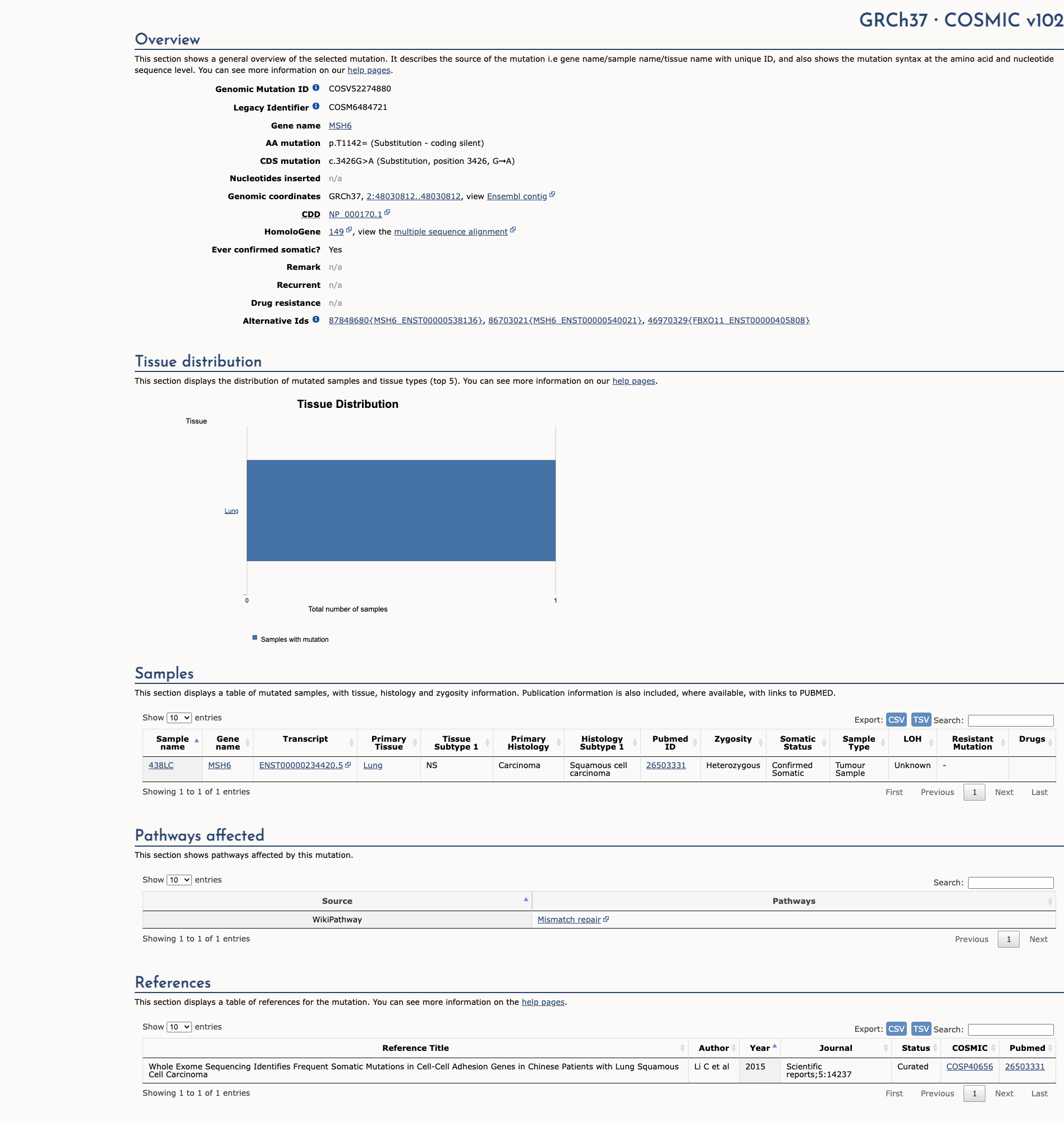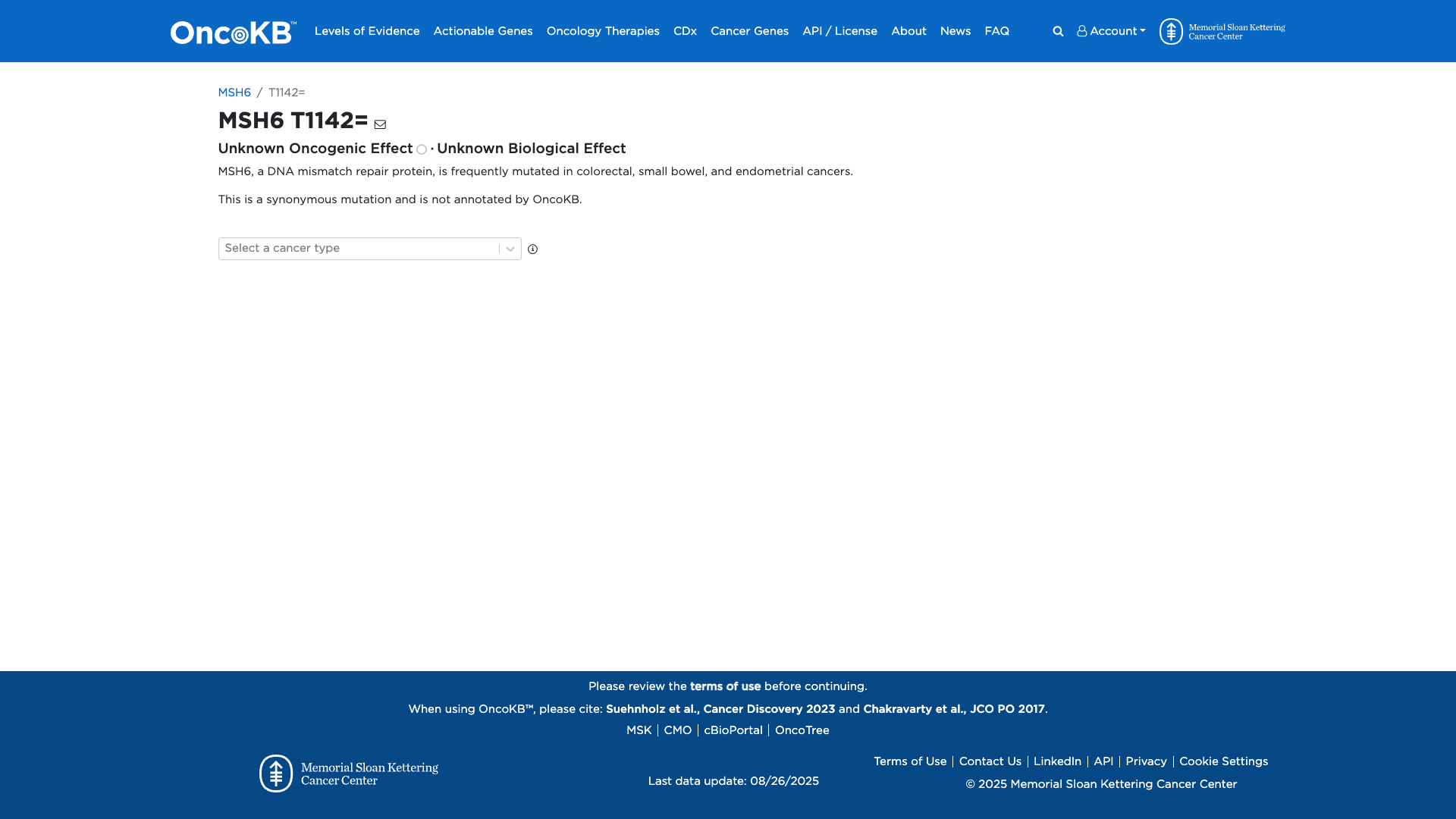MSH6 c.3426G>A, p.Thr1142=
NM_000179.3:c.3426G>A
COSMIC ID: COSM6484721
Likely Benign
This synonymous MSH6 variant (c.3426G>A, p.T1142=) is extremely rare in population databases (PM2), predicted to have no splicing impact (BP4, BP7), and reported as benign by reputable sources (BP6). In the absence of any pathogenic evidence, the four supporting benign criteria justify a Likely Benign classification.
ACMG/AMP Criteria Applied
PM2
BP4
BP6
BP7
Genetic Information
Gene & Transcript Details
Gene
MSH6
Transcript
NM_000179.3
MANE Select
Total Exons
10
Strand
Forward (+)
Reference Sequence
NC_000002.11
Alternative Transcripts
| ID | Status | Details |
|---|---|---|
| NM_000179.2 | RefSeq Select | 10 exons | Forward |
| NM_000179.1 | Alternative | 10 exons | Forward |
Variant Details
HGVS Notation
NM_000179.3:c.3426G>A
Protein Change
T1142=
Location
Exon 5
(Exon 5 of 10)
5'Exon Structure (10 total)3'
Functional Consequence
Loss of Function
Related Variants
Alternate Identifiers
COSM6484721
Variant interpretation based on transcript NM_000179.3
Genome Browser
Loading genome browser...
HGVS InputNM_000179:c.3426G>A
Active Tracks
ConservationRefSeqClinVargnomAD
Navigation tips: Use mouse to drag and zoom. Click on features for details.
Clinical Data
Global Frequency
0.00159%
Rare
Highest in Population
Remaining individuals
0.0163%
Low Frequency
Global: 0.00159%
Remaining individuals: 0.0163%
0%
0.05%
0.1%
1%
5%
10%+
Allele Information
Total: 251326Alt: 4Homozygotes: 0
ACMG Criteria Applied
PM2
This variant is present in gnomAD (MAF= 0.00159%, 4/251326 alleles, homozygotes = 0) and at a higher frequency in the Remaining individuals population (MAF= 0.0163%, 1/6130 alleles, homozygotes = 0). The variant is rare (MAF < 0.1%), supporting PM2 criterion application.
Classification
1 publications
Likely Benign
Based on 13 submitter reviews in ClinVar
Submitter Breakdown
11 LB
2 B
Pathogenic
Likely Path.
VUS
Likely Benign
Benign
Publications (1)
Clinical Statement
This variant has been reported in ClinVar as Likely benign (11 clinical laboratories) and as Benign (2 clinical laboratories) and as Likely Benign (1 clinical laboratories).
Functional Impact
Functional Domain
Hotspot Status
Not a hotspot
Domain Summary
This variant is not located in a mutational hotspot or critical domain (0 mutations).
Related Variants in This Domain
Computational Analysis
Pathogenicity Predictions
Predictor Consensus
Mixed/VUS
PP3 Applied
No
Additional Predictors
Benign:
CADD: 0.35
VCEP Guidelines
Applied ACMG/AMP Criteria (VCEP Specific) VCEP Guidelines
PVS1
PVS1 (Not Applied) Strength Modified
According to VCEP guidelines, the rule for PVS1 is: "Very Strong Nonsense/frameshift variant introducing Premature Termination Codon (PTC) ≤ codon 1341 in MSH6...". The evidence for this variant shows it is a synonymous substitution (p.T1142=) and does not introduce a PTC or disrupt the reading frame. Therefore, this criterion is not applied.
PS1
PS1 (Not Applied) Strength Modified
According to VCEP guidelines, the rule for PS1 is: "Strong A predicted missense substitution that encodes the same amino acid change with a different underlying nucleotide change previously established by this VCEP as Pathogenic...". The evidence for this variant shows no amino acid change (synonymous). Therefore, this criterion is not applied.
PS2
PS2 (Not Applied) Strength Modified
According to VCEP guidelines, the rule for PS2 is: "Very Strong ≥ 4 de novo points...". No de novo occurrence or parental testing information is available. Therefore, this criterion is not applied.
PS3
PS3 (Not Applied) Strength Modified
According to VCEP guidelines, the rule for PS3 is: "Strong Calibrated functional assays with functional odds for Pathogenicity > 18.7...". No functional assay data exist for this variant. Therefore, this criterion is not applied.
PS4
PS4 (Not Applied) Strength Modified
According to standard ACMG guidelines, the rule for PS4 is: "The prevalence of the variant in affected individuals is significantly increased compared to controls.". No case–control or segregation prevalence data are available. Therefore, this criterion is not applied.
PM1
PM1 (Not Applied) Strength Modified
According to standard ACMG guidelines, the rule for PM1 is: "Location in a mutational hot spot and/or well‐established functional domain without benign variation.". This variant is synonymous and not located in a known functional domain hotspot. Therefore, this criterion is not applied.
PM2
PM2 (Supporting) Strength Modified
According to VCEP guidelines, the rule for PM2 is: "Supporting Absent/extremely rare (<1 in 50,000 alleles) in gnomAD v4 dataset.". The evidence for this variant shows a MAF of 0.00159% (4/251,326 alleles), which is below the threshold of 0.002%. Therefore, this criterion is applied at Supporting strength.
PM3
PM3 (Not Applied) Strength Modified
According to VCEP guidelines, the rule for PM3 is: "Very Strong ≥ 4 points for detected in trans with a pathogenic variant in a recessive disorder...". No trans-phase or recessive co-occurrence data are available. Therefore, this criterion is not applied.
PM4
PM4 (Not Applied) Strength Modified
According to standard ACMG guidelines, the rule for PM4 is: "Protein length changes as a result of in‐frame deletions/insertions in a non‐repeat region or stop-loss variants.". This variant is synonymous and does not alter protein length. Therefore, this criterion is not applied.
PM5
PM5 (Not Applied) Strength Modified
According to VCEP guidelines, the rule for PM5 is: "Moderate Missense change at an amino acid residue where a different missense change was classified as Pathogenic...". This variant is synonymous, not missense. Therefore, this criterion is not applied.
PM6
PM6 (Not Applied) Strength Modified
According to standard ACMG guidelines, the rule for PM6 is: "Assumed de novo, but without confirmation of paternity and maternity.". No de novo data are available. Therefore, this criterion is not applied.
PP1
PP1 (Not Applied) Strength Modified
According to standard ACMG guidelines, the rule for PP1 is: "Co-segregation with disease in multiple affected family members.". No segregation data are available. Therefore, this criterion is not applied.
PP2
PP2 (Not Applied) Strength Modified
According to standard ACMG guidelines, the rule for PP2 is: "Missense variant in a gene with a low rate of benign missense variation and where missense is a common mechanism of disease.". This variant is synonymous. Therefore, this criterion is not applied.
PP3
PP3 (Not Applied) Strength Modified
According to VCEP guidelines, the rule for PP3 is: "Supporting Predicted splice defect for non-canonical splicing nucleotides using SpliceAI with delta score ≥ 0.2.". SpliceAI predicts a maximum delta score of 0.01 (<0.2). Therefore, this criterion is not applied.
PP4
PP4 (Not Applied) Strength Modified
According to VCEP guidelines, the rule for PP4 is: "Supporting 1 CRC/Endometrial MSI-H tumor with consistent MMR protein loss.". No tumor phenotype or MSI data are available. Therefore, this criterion is not applied.
PP5
PP5 (Not Applied) Strength Modified
According to standard ACMG guidelines, the rule for PP5 is: "Reputable source reports variant as pathogenic, but evidence not available.". No reputable source reports this variant as pathogenic. Therefore, this criterion is not applied.
BA1
BA1 (Not Applied) Strength Modified
According to VCEP guidelines, the rule for BA1 is: "Stand Alone GnomAD v4 Grpmax filtering allele frequency ≥ 0.0022 (0.22%).". The MAF of 0.00159% is below the 0.22% threshold. Therefore, this criterion is not applied.
BS1
BS1 (Not Applied) Strength Modified
According to VCEP guidelines, the rule for BS1 is: "Strong GnomAD v4 Grpmax filtering allele frequency ≥ 0.00022 and < 0.0022 (0.022–0.22%).". The MAF of 0.00159% is below 0.022%. Therefore, this criterion is not applied.
BS2
BS2 (Not Applied) Strength Modified
According to VCEP guidelines, the rule for BS2 is: "Strong Co-occurrence in trans with a known pathogenic sequence variant...". No co-occurrence data are available. Therefore, this criterion is not applied.
BS3
BS3 (Not Applied) Strength Modified
According to VCEP guidelines, the rule for BS3 is: "Strong Calibrated functional assays with functional odds for Pathogenicity ≤ 0.05 OR Synonymous substitutions with no mRNA aberration in assays.". No experimental mRNA or functional assay data are available. Therefore, this criterion is not applied.
BS4
BS4 (Not Applied) Strength Modified
According to standard ACMG guidelines, the rule for BS4 is: "Lack of segregation in affected members of a family.". No segregation data are available. Therefore, this criterion is not applied.
BP1
BP1 (Not Applied) Strength Modified
According to standard ACMG guidelines, the rule for BP1 is: "Missense variant in a gene for which primarily truncating variants are known to cause disease.". This variant is synonymous. Therefore, this criterion is not applied.
BP2
BP2 (Not Applied) Strength Modified
According to standard ACMG guidelines, the rule for BP2 is: "Observed in trans with a pathogenic variant for a fully penetrant dominant gene/disorder or in cis with a pathogenic variant.". No phasing or cis/trans data are available. Therefore, this criterion is not applied.
BP3
BP3 (Not Applied) Strength Modified
According to standard ACMG guidelines, the rule for BP3 is: "In-frame deletions/insertions in a repetitive region without a known function.". This variant is synonymous. Therefore, this criterion is not applied.
BP4
BP4 (Supporting)
According to VCEP guidelines, the rule for BP4 is: "Supporting For intronic and synonymous variants: SpliceAI predicts no splicing impact with delta score ≤ 0.1.". SpliceAI predicts a maximum delta score of 0.01 (≤ 0.1). Therefore, this criterion is applied at Supporting strength.
BP5
BP5 (Not Applied) Strength Modified
According to standard ACMG guidelines, the rule for BP5 is: "Variant found in a case with an alternate molecular basis for disease.". No alternate molecular diagnosis is reported. Therefore, this criterion is not applied.
BP6
BP6 (Supporting)
According to standard ACMG guidelines, the rule for BP6 is: "Reputable source recently reports variant as benign, but the evidence is not available to the laboratory to perform an independent evaluation.". ClinVar records this variant as Likely benign (11 labs) or Benign (2 labs). Therefore, this criterion is applied at Supporting strength.
BP7
BP7 (Supporting)
According to VCEP guidelines, the rule for BP7 is: "Supporting A synonymous (silent) or intronic variant at or beyond -21/+7 (5′/3′ exonic). Variants may satisfy both BP7 and BP4.". The variant is synonymous and SpliceAI predicts no splicing impact, consistent with being outside canonical splice sites. Therefore, this criterion is applied at Supporting strength.



